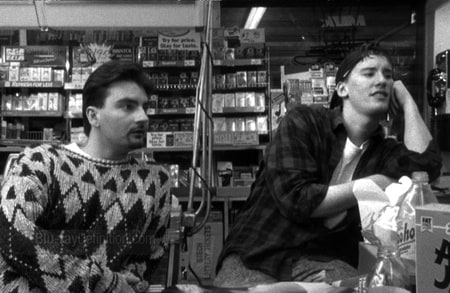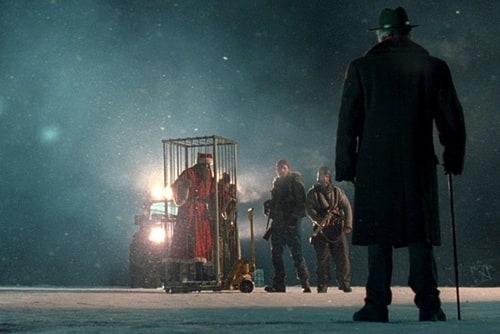Produced in 1994 on a measly $27,000 budget, Clerks. was the feature film debut for Kevin Smith, and it proved to be his ticket into the industry. Smith reportedly financed the flick himself, selling off his comic book collection, maxing out his credit cards and borrowing money from his parents to produce this foul-mouthed, witty and extremely enjoyable small-scale comedy. Love it or hate it, Clerks. defines a generation, and it has amassed an enormous cult following in the years since its release. And on top of being frequently entertaining, Clerks. is imbued with topics and ideas that resonate with people, regardless of how profane the dialogue is.

In the small township of Leonardo, New Jersey, Dante Hicks (O'Halloran) works a dead-end job at a local Quick Stop convenience store while his friend Randal (Anderson) watches over the neighbouring video shop. In the early hours of a Saturday morning, Dante is forced to come into work to even though it's his day off. From there, Clerks. is very much a day-in-the-life portrayal of Dante and Randal as they endure ungrateful customers and attempt to sort out their personal problems. Dante deals with his love life after finding out that one of his ex-girlfriends is getting married, while Randal spits blatant misanthropy and cynicism at every customer he sees. All the while, a pair of stoners named Jay (Mewes) and Silent Bob (Smith) hang around the store to sell marijuana, occasionally shoplift, and generally chill out.
Clerks. is a plotless 90-minute movie set almost entirely in one single location concerning a small group of main characters. And since it was shot on 16mm black and white film stock by an inexperienced crew, the film isn't exactly an aesthetically pleasing experience. For all intents and purposes, Clerks. should not have worked, but it does on account of Smith's witty screenplay, the well-judged pacing and the selection of entertaining characters. Smith has created some of the funniest, most intelligent speakers in the movie world; people who mix terms like "oral bowel movement" and "managerial control" with scores of profanity. Clerks. also excels as a biting commentary on working in retail. It's clear that Smith has dealt with his fair share of ignorant, moronic and rude souls during his time as a retail clerk, and wanted to expose the true nature of such people. Smith did not even need to use exaggeration; the idiosyncrasies displayed by the customers are hilariously authentic, and anyone who has worked behind a counter for more than a week will guffaw at how truthful the film is. At one stage, Randal even exclaims "This job would be great if it wasn't for the fucking customers" - something that any retail worker can relate to.

One has to admire Smith's dedicated work ethic. He was employed at the convenience store where the film was shot, and, for three straight weeks, he worked from 6am until 11pm, then filmed until 4am and got about an hour of sleep before repeating the cycle. However, while Clerks. is peppered with witty dialogue and brilliant jokes, it is an independent film created by a first-timer, and it does look rough. To save money, Smith shot on cheap film stock, leading to a grainy-looking picture with some harsh editing and odd cinematography, on top of various other technical issues. But while the film is not pretty, the raw moviemaking gives the film a sense of character.
For the most part, the acting is fairly amateurish, which is perhaps to be expected since Smith used his family and friends. (Some people even played various roles.) However, leads Brian O'Halloran and Jeff Anderson are exceptional, displaying top-notch comic timing and emanating boundless charm. O'Halloran and Anderson exchange banter beautifully, and their interactions always sparkle. Also of note is an amusing Jason Mewes as Jay, and Kevin Smith himself who's funny and effective as Silent Bob.

Years on, Clerks. still holds up. It's very much a product of his time with its dated pop culture riffs and heavily out-dated depiction of video stores. (Remember VHS tapes? Remember when people rented films on a consistent basis, rather than pirating 90% of new releases?) However, its early '90s characteristics are all part of the charm. This is not family-friendly viewing due to all the expletives (the MPAA tried to slap the film with an NC-17 rating due to its dialogue), but those who enjoy more adult-oriented comedies should have an absolute ball with this one.
7.8/10
 Login
Login
 Home
Home 183 Lists
183 Lists 1671 Reviews
1671 Reviews Collections
Collections
 0 comments,
0 comments, 




































